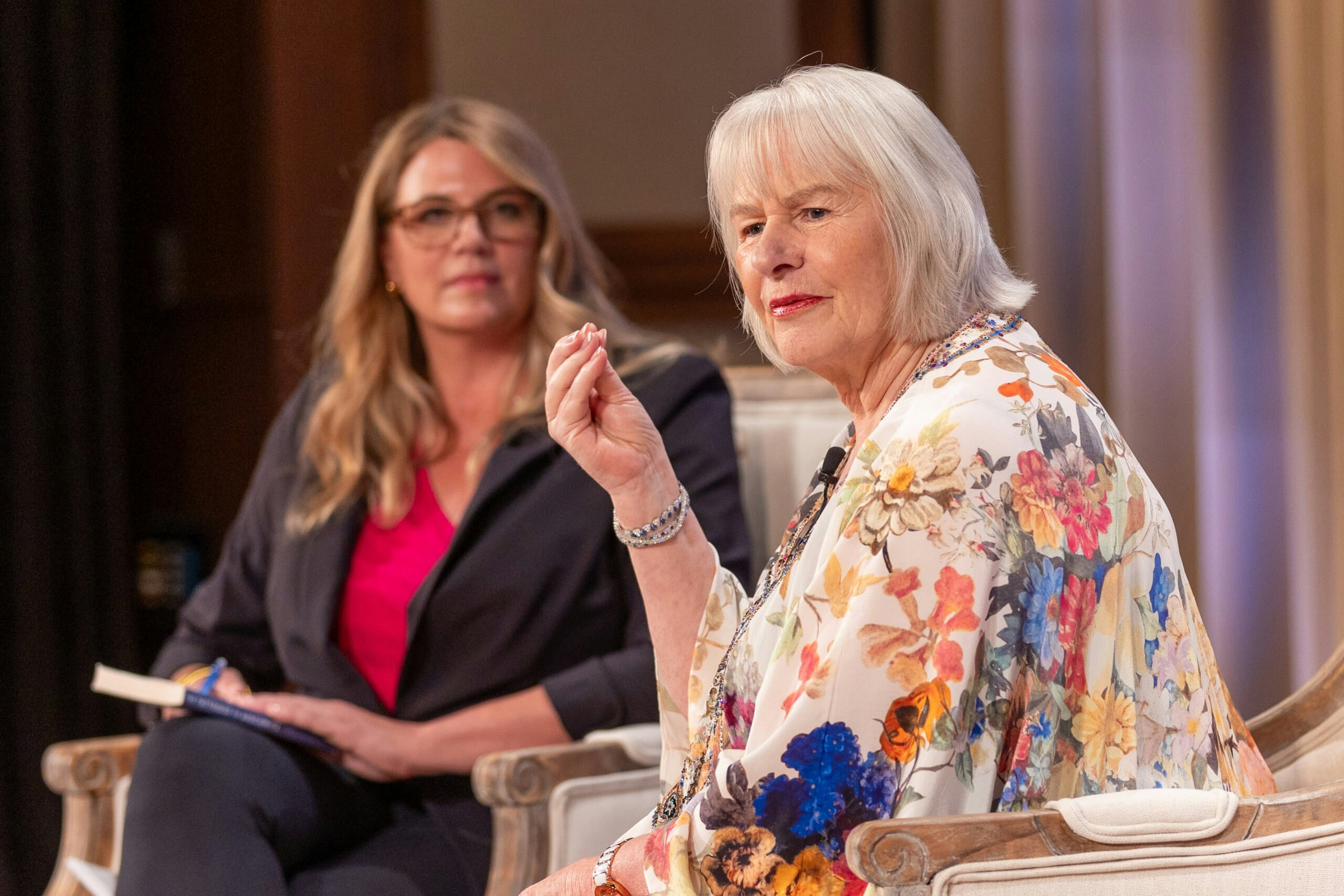Crystal Cazier, Senior Program Manager of the Bush Institute's Global Health Initiative, explains the importance of foreign aid and its significance and impact on United States' prosperity.
The United States holds significant influence on the world stage and has used its position to guide others toward the values Americans hold high – democratic governance, free market economies, and opportunity for individual success. Although the rhetoric surrounding these policies is designed to make them sound altruistic, the fact is that having others aligned with U.S. interests and norms reduces the potential for armed conflict, strengthens American leverage vis-a-vis other governments, and buttresses American positions in international bodies like the North Atlantic Treaty Organization (NATO) and the United Nations. As a result, the United States and the American people are more secure, and citizens around the world are safer and more prosperous. We have been able to do this because of the strength of our economy, the force of our military, and the diplomatic power we possess.
The United States’ foreign policy follows the philosophy of President Theodore Roosevelt to “speak softly and carry a big stick.” The soft speaking the U.S. does is not necessarily literal words. Money talks. A form of soft power, the United States’ foreign aid has contributed to our ability to get our way and achieve outcomes that are good for Americans.
What is foreign aid?
Foreign aid is the resources – financial as well as other goods, or technical or military assistance – provided by the United States government to other countries or international organizations. Aid supports development, health, stability, and growth of other regions and countries of the world and also is negotiated with American interests in mind.
How much does the U.S. spend each year in foreign aid?
U.S. spending on foreign aid as a percent of the total budget has been decreasing over the past four decades, with no real difference in the percent of the budget committed to foreign aid between Democrat or Republican administrations. While in the late 1970s, nearly 2% of the budget was dedicated to foreign aid, it has been steadily decreasing and recently is around 1%.
Measured as a percent of gross domestic product (GDP), foreign aid has decreased over the same time period. So, although the total dollar amount has increased, foreign aid constitutes a diminishing portion of our national budget.
For fiscal year 2021, (October 2020 – September 2021), Congress approved $62.7 billion for the international affairs budget in December 2020. The American Rescue Plan Act signed by President Biden in March 2021 added $10 billion for the international response to COVID-19. This combined allocation is approximately 1% of the funds the U.S. plans to spend this year.
Where does our foreign aid go?
Foreign aid is allocated to other countries, but only a fraction of it goes directly to other countries’ governments. The U.S. government contracts with non-governmental organizations – both U.S. and locally based, multilateral institutions, and other aid recipients – mostly to buy American-made goods and services and carry out programs. For FY2021, the top recipients of U.S. foreign assistance are primarily in the form of security grants with Israel, Egypt, and Jordan receiving a combined $6 billion. The U.S. also invests heavily elsewhere including sub-Saharan Africa, Latin America, and Afghanistan.
What does our foreign aid do?
Foreign aid is not just a handout; it is an investment in U.S. ingenuity, security, growth, and global standing. U.S. foreign aid and assistance programs have absolutely had benefit to our global neighbors. Thanks to U.S. investments through American taxpayer contributions, people who would have died of deadly diseases have lived, kids who would not have gone to school are receiving an education, and people who would have gone hungry have been provided food.
While at the Bush Institute we do believe that America’s prosperity means we have a moral obligation to help our neighbors, foreign aid is not strictly an act of compassion. Foreign aid benefits America both abroad and at home. When the U.S. supports development, security, and growth in other parts of the world, conflict and disease are reduced, to the benefit of Americans worldwide. Other countries want to work with us, trade with us, and are more likely to respect American values – such as democracy and human rights – creating a more secure world. These allegiances allow the United States to achieve American objectives through the efforts and sacrifice of others, leveraging our resources and enhancing the security and prosperity of the American people. We need allies abroad to promote global security to keep us safe. We need partners who will buy American goods and products, and who also want to sell essential products back. We also need businesses that will benefit the American economy with jobs and investments, and countries that will make it easy for Americans to invest abroad, ultimately returning revenue to the United States.
Making friends abroad also helps keep other actors whose motives might be less in tune with our own at bay. Other countries want to work with those who will provide benefit to them. When the U.S. scales back its international engagement, another country will fill the void. The antidote is not for the U.S. to pull in further, but to be bolder in our engagement abroad, including by supporting countries who need our assistance and are open to playing by our rules.
Why should we continue to invest in foreign aid?
Ensuring the foreign aid budgets are fully funded is a good investment in the United States. Pulling back would only have negative consequences for the United States and our allies. Importantly, we have seen increased spending on international assistance from countries whose objectives differ from ours. China and Russia, for instance, have not shown a commitment to fighting corruption in developing countries; on the contrary, some of their assistance spending has contributed directly to misappropriation of funds. They are given with predatory lending structures and little regard for how that loan is overseen, how countries treat their citizens, or how natural resources are responsibly managed. If the United States reduces its engagement, our ability to foster a transparent operating environment will corrupt businesses in general, with potentially serious implications for the United States.
Amid COVID-19, studies have found that the global economy will lose trillions of dollars, with high income countries particularly affected. We live in a globalized economy – and that is a good thing. But how other economies are doing is going to affect how prosperous we are.
In the same vein, COVID-19 has made it abundantly clear that infectious disease spreads quickly, and a border drawn on a map will not protect us. Our health in the U.S. is not guaranteed solely by our own domestic health care system, but to some extent by the health care and public health infrastructure elsewhere. U.S. investments in global health security will help to ensure the wellbeing of Americans against future outbreaks. For example, even as the U.S. races to vaccinate its own population, the unmitigated spread of COVID-19 elsewhere has already spawned new variants that undermine the efficacy of our vaccines. It behooves the U.S. to have an aggressive strategy for engagement and support of international vaccine scale up.
Has the U.S. always given foreign aid?
Although the recipients and motivations for foreign aid have changed over the years in response to global realities and U.S. priorities at home and abroad – and, not incidentally, as aid recipients like Botswana, Chile, the Czech Republic, and South Korea, have grown and prospered – the U.S. has been dedicating a small portion of its budget to foreign aid since the end of World War II. As an important economic and military partner of the United States, we supported Western Europe’s return to stability and strength, helping them fend off takeover attempts by the now-defunct Soviet Union.
In 1961, President Kennedy signed the Foreign Assistance Act, which set up the United States Agency for International Development to handle all U.S. foreign aid programs. Throughout the Cold War era, foreign aid was used as a strategy against the expansion of communism.
Entering the late 1990s, foreign aid spending dipped, but President George W. Bush recognized the importance of foreign aid as part of international relations and diplomacy. The Bush administration invested heavily in the Middle East and Afghanistan to curb the threat of terrorism, and significantly increased investments in sub-Saharan Africa.
President Obama continued these programs under his administration and leveraged foreign aid as an important piece of his foreign policy strategy and engagement.
Although President Trump’s budget proposals suggested significant cuts in foreign aid and attempted other tactics to slash foreign aid spending, Congress overwhelmingly rejected these actions and upheld foreign aid appropriations.
President Biden has signaled his intention to continue and expand U.S. foreign aid investments, including through engagement in the international response to and rebuilding from COVID-19.
Shouldn’t other countries also do their part?
Yes, and they do. While the U.S. spends the most in total, it spends a relatively small amount of its Gross National Income (GNI) on foreign aid compared to other high-income countries. U.S. official development assistance, as the Organization for Economic Cooperation and Development measures it, amounted to 0.154% of GNI in 2019, a ratio lower than that of 29 of the 44 countries the OECD includes in a comparison on its website.
What about all the problems at home?
There is no argument that the U.S. has domestic priorities that require attention including, but not limited to, deep and pervasive inequalities, a burgeoning national debt, stark partisan divides, and economic uncertainties, but foreign aid remains a cost-effective tool to reduce the possibility that we might need to send our sons and daughters to fight in foreign wars. Investing abroad is literally an investment in Americans here at home.
Because foreign aid spending is a small percent of our national budget, cutting it will not make a dent in our national debt, and could do more harm than good. In fact, the FY21 foreign aid allocations are only 3% of the projected one-year fiscal deficit for FY21. The significant drivers of our national debt are instead the aging of our population and health care costs, funded through mandatory programs like Medicare and Social Security.
Foreign aid remains an issue where Democrats and Republicans consistently find common ground. In a polarized political environment, having an issue where collaboration and agreement exist reignites faith in bipartisanship and civility in politics.
Additional Resources:
For more information on this topic, check out these resources:
- Q&A: Why Should the U.S. Provide Foreign Aid to Another Country?
- Cutting Foreign Aid is Not the Answer to Our Debt Crisis
- What Every American Should Know about U.S. Foreign Aid
- Department of State, Foreign Operations, and Related Programs: FY2021 Budget and Appropriations
- Foreign Assistance: An Introduction to U.S. Programs and Policy
- The History of US Foreign Aid and Why It’s as Important as Ever
- USGLC’s Budget Updates website























